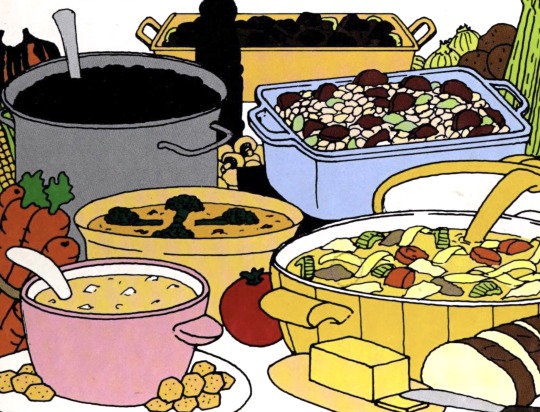#Stews
Explore tagged Tumblr posts
Text

Vegetable Miso Stew (Vegan)
#vegan#lunch#dinner#soups#stews#miso soup#miso#squash#kabocha squash#cabbage#garlic#ginger#plant milk#tofu#mushrooms#mirin#tamari#dumplings#onion#olive oil#pomegranate#green onion#sesame seeds#chili
74 notes
·
View notes
Photo
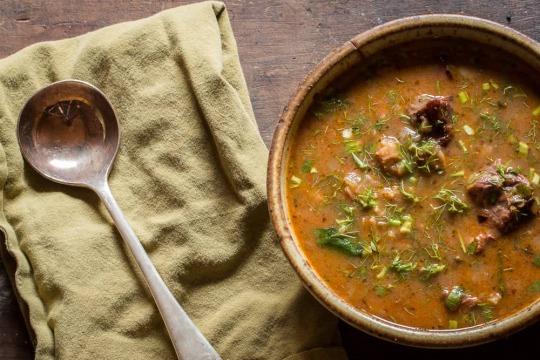
Sweet and sour spiced venison stew flavored with dried wild plum leather
304 notes
·
View notes
Text
This is a niche one but I just have to know
#soup#soups#soup posting#polls#ramen#stew#poll#stews#chowder#noodle#disability#disabled#chronically ill#cripple punk#also please note: i do not inherently believe that disabled and chronically ill should be separated into different categories#because i do believe that chronically ill folks do fall under the larger disabled commuinity#but i wanted to be as inclusive with my phrasing as possible#mostly because i was thinking about my oan relationship between chronic illness and my love of soup and a cozy lifestyle#thinking about how weve designsted soup as a sick day food
84 notes
·
View notes
Text






[ON MY WAY UP NORTH, UP ON THE VENTURA. I PULLED BACK THE HOOD AND I WAS TALKING TO YOU. AND I KNEW THEN IT WOULD BE A LIFE LONG THING, BUT I DIDN'T KNOW THAT WE, WE COULD BREAK A SILVER LINING AND MAKE THESE BIG VATS OF GUMBOS OR STEWS, THEN THEY LEAVE EVERYTHING IN THERE, ALL IT DOES IS JUST... MUSH.]
#s04e08 big flavor#guy fieri#guyfieri#diners drive-ins and dives#my way#life long#silver lining#big vats#north#the#ventura#hood#gumbos#stews#everything#mush
7 notes
·
View notes
Text

AFANG - Tripe Stew from West Africa
Without any iota of doubt, soups are a big part of the African cuisine, in fact, it is wise to say that African soups are the main attraction of cuisine in the continent.
African soups can be made with a combination of vegetables and ingredients that are native to the countries where they are most eaten.
Very many African soups are usually eaten with other food staples such as rice, fufu, banku, sadza, garri, pounded yam, and so on.
Below are some of our favorite soups from different African countries.
1. Okra soup

Okra soup is a popular west African dish with okra as its main ingredient. Although this deliciously slimy dish can be cooked with the local palm oil, it is also a good choice for people who are wary of adding oil to their soups.
2. Abenkwan
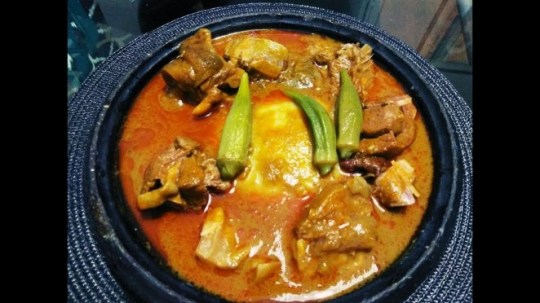
Abenkwan is a Ghanaian soup made from the nuts of the palm tree. The pulp is extracted from the palm fruits and cooked in combination with spices and preferred meat of choice.
Abenkwan has an earthy flavor thanks to the addition of the palm fruit pulp (which is different from the palm oil). Serve warm with rice balls or Kokonte and you will be satisfied to the moons and back.
3. Muriwo na Nyama
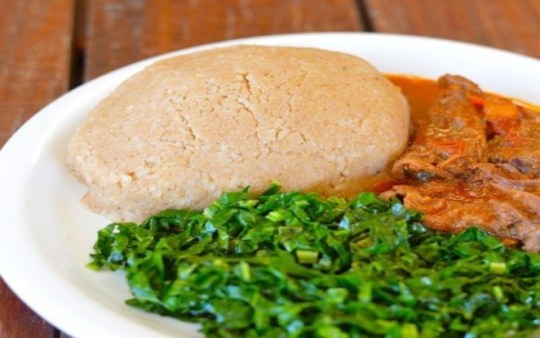
Muriwo na nyama is also known as leafy-beefy or high fields stew. It is native to Zimbabwe, highly nutritious and cn be eaten with sadza.
4. Pepper soup
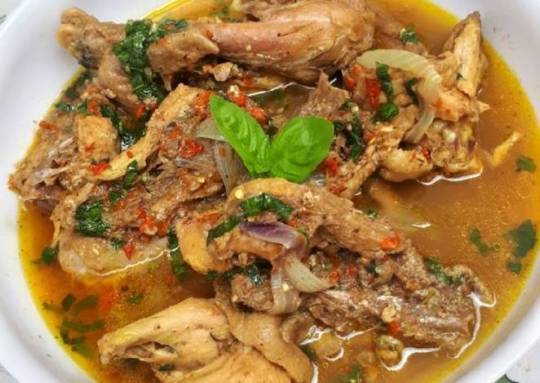
Pepper soup is a spicy African soup that will make your taste buds tingle with excitement. The soup is gotten from the stock of the meat or fish used. It is also spiced with local ingredients, giving it a tantalizing aroma and taste that will make you hungry even if you just had dinner.
For the best experience, have your pepper soup hot–not scalding hot of course– and thank us later.
5. Agushie/Egusi soup

Agushie (Ghana)/Egusi(Nigeria) is a delicious soup cooked with shelled melon seeds. The method of preparation might differ across the different regions in which this soup is eaten but it ultimately includes the addition of leafy greens, seasoning and palm oil. In Nigeria, its best served with freshly pounded yam.
6. Domoda

Domoda is the Gambia’s national dish, second only to Yassa. It is a yummy soup cooked with unsweetened peanut butter. It might also contain sweet potatoes. Domoda is better enjoyed with rice.
7. Afang
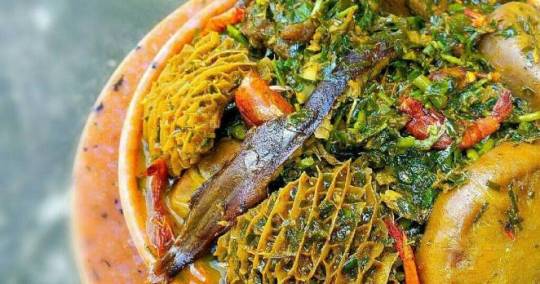
Afang is a delightful and satisfying soup from southern Nigeria. It is similar to the eru soup in Cameroon. They both make use of the afang/okazi leaves. However, the afang leaves are pounded and used in addition to water leaf. Afang soup is rich in deliciousness and best served hot with fufu and lots of meat.
8. Ndole
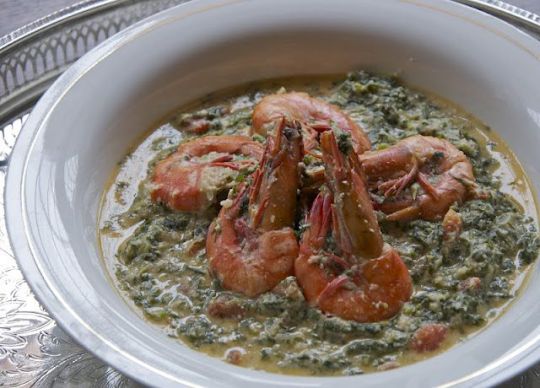
Ndole is another leafy vegetable soup with its home in Cameroon. It is often considered the national dish of the central African country. It’s a creamy and nutritious soup cooked with pureed peanuts and bitter leaf.
9. Afia efere/Ofe nsala
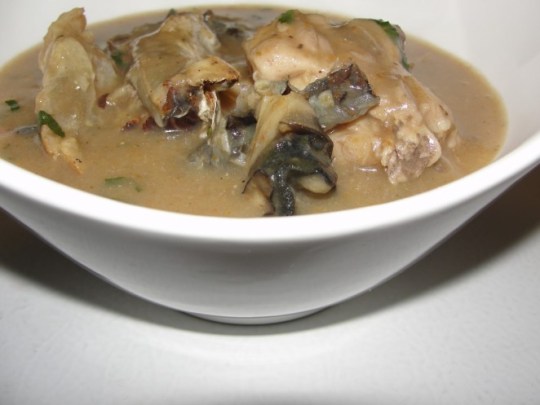
In the Nigerian local languages of Annang and Igbo, afia efere and ofe nsala respectively mean ‘white soup’ in English. Technically, this mouth-watering spicy soup should be called ‘brown soup’ but where’s the fun in that? It is apparently called ‘white’ for the lack of palm oil use.
10. Ewedu Soup
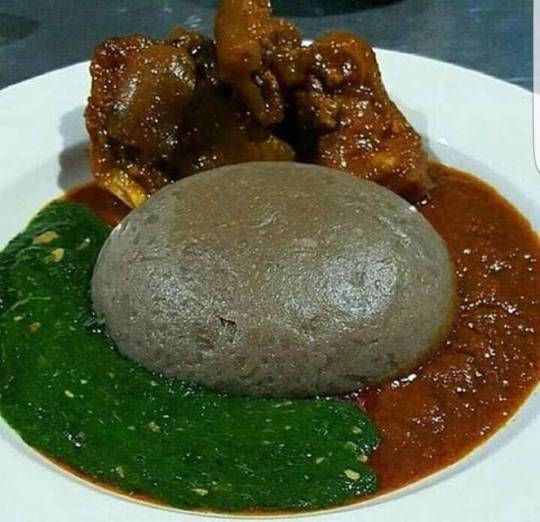
Ewedu is a Nigerian soup which is popular among the Yorubas. It’s a leafy vegetable soup but unlike other African soups, the greens (jute leaves) are pureed and cooked with nothing more than salt, locust beans and often potash.
It is usually served in addition to peppered stews (as pictured above) or gbegiri (beans soup). Yorubas love to eat this with amala, a starchy swallow made from yam peels and sometimes plantains.
#west african food#cooking#african food#stews#soups#main dish#african#Top 10 Delicious African Soups That Will Make You Salivate And Where They Are Best Made
87 notes
·
View notes
Text
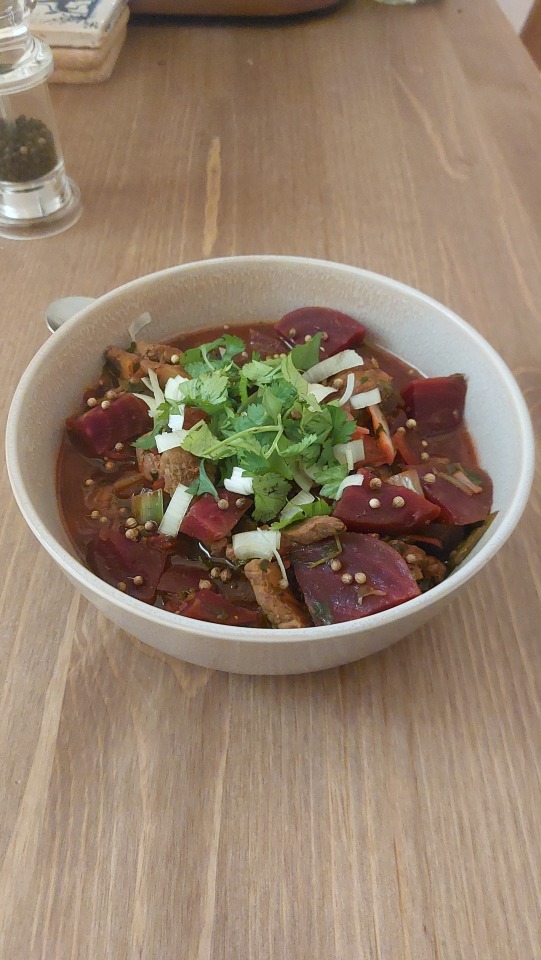
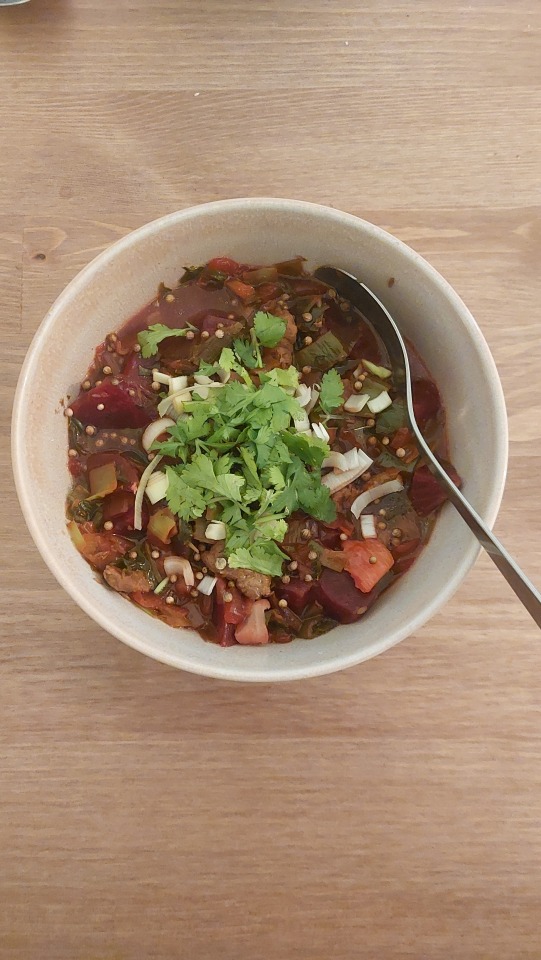
TUH'U (c. 1740 BCE)
The next Tasting History dish I had to try was Babylonian Tuh'u, a beet and lamb stew. The recipe for this dish is from the Yale Tablets, ancient Mesopotamian cuneiform tablets from 1740 BCE held at Yale University. According to these tablets, Babylonians loved eating stew - this stew recipe was just one of many stamped into these tablets. Max really liked Tuh'u when he made it, and even said it wouldn't be out of place on a modern menu. It's very impressive to see the Babylonians making meals with complex flavour combinations that can even please the palatte of people thousands of years in the future. See Max’s video on how to make it here or see the ingredients and process at the end of this post, sourced from the Youtube description of the video.
My experience making it:
I made a simple change or two from the modern recipe below. I used beef instead of lamb, mainly because the butcher I usually source lamb from was closed this week (and it's otherwise hard to find where I live). Further, I didn't end up using any of the water that Max lists in the ingredients. In terms of beer, I used Erdinger Weißbier, since it is very easy to find where I live. Unfortunately, sour beer is much harder to find, so I didn't consider using it.
In terms of preparation, this recipe requires lots of chopping (meat, onion, leek, shallot, arugula, cilantro...) and a little bit of grinding in the mortar & pestle (cumin seeds and garlic). I was very excited to use my new mortar & pestle, I love it already! The cumin seeds smelled divine while I was crushing them. Due to the long simmer time, the recipe took me about 1 hour and 30 minutes to make. The broth doesn't really thicken like a normal stew, so I decided to leave a little liquid and not boil all of it away, as the broth usually retains lots of the flavour. Due to the beautiful colour of the beets and the pops of fresh green from the cilantro, this dish was visually pretty to look at once it was served. The result was, like Max said, a dish I could definitely see being served in a restaurant today. The Babylonians had good taste!
My experience tasting it:
I tried this one on my own since my husband got home from work pretty late. The first bites were full of flavour - particularly the cilantro's. The texture and pop of flavour from the dried coriander seeds were also present, as well as the cumin, onion, and beet flavour. The beef didn't add much flavour, but definitely soaked up the flavour of the dish like a sponge. I enjoyed every bite of this one, and even saved some for leftovers to have at work. I had a feeling I would like this dish, because I like all the ingredients, and especially beets. I wasn't so sure if my husband would like it, but when he got home, he enthusiastically finished his bowl at record speed, exclaiming at how good it was in between spoonfuls. We both agreed it is the best historical dish I've made yet, and the best dish I've made in a while otherwise. I would actually consider sharing this recipe with friends, especially since the ingredients are fairly easy to find, and the process is fairly simple. Not to mention, the outcome was delicious! If you end up making it, if you liked it, or if you changed anything from the original recipe, do let me know!
Links to harder-to-find ingredients:
Cumin Seed
Coriander Seed
Tuh'u original recipe (c. 1740 BCE)
Sourced from the Yale Babylonian Tablets
Tuh’u sirum saqum izzaz me tukan lipia tanaddi tusammat tabatum sikara susikillum egegerum kisibirrum smidu kamunum alutum tukammas-ma karsum hazannum teterri kisibirrum ina muhhi sipki tusappah suhutinnu kisibirrum isarutu tanaddi. Tuh’u. Lamb leg meat is used. Prepare water. Add fat. Sear. Add in salt, beer, onion, arugula, cilantro, samidu, cumin, and beets. Put the ingredients in the cooking vessel and add crushed leek and garlic. Sprinkle the cooked mixture with coriander on top. Add suhutinnu and fresh cilantro.
Modern Recipe
Based on the Yale Babylonian Tablets and Max Miller’s version in his Tasting History video.
Ingredients:
1 lb (450g) leg of lamb (or other meat), chopped in bite size pieces
3-4 tbsp oil or rendered fat
1 ½ tsp salt
2 cups (475ml) water (only to add if needed)
12 oz (350ml) beer (sour beer and German Weissbier preferred)
1 large onion, chopped
2 cups arugula, chopped
3/4 cup fresh cilantro, chopped
2 tsp cumin seeds, crushed in a mortar & pestle
2 large beets (approx. 4 cups), diced
1 large leek, minced
3 cloves garlic
1 tbsp dry coriander seeds
additional chopped cilantro for garnish
Samidu* (1 Persian shallot)
Suhutinnu* (Egyptian leek for garnish)
*These ingredients have no definite translation; the shallot and leek are the best guesses of scholars at Yale and Harvard Universities)
Method:
Add the oil/fat to a large pot and set over high heat.
Sear the lamb for several minutes in the oil until lightly browned.
Add the onions and let cook for 5 minutes.
Add the beets and let cook for 5 minutes.
Add the salt, beer, arugula, cilantro, samidu (shallot), and cumin and bring to a boil.
Mash the garlic into a paste and mix with the leek, then add to the pot.
Lower heat to medium and let simmer for approximately 1 hour, or until the beets and meat are cooked to your liking. Add water if you prefer.
Once cooked, dish it into a bowl and sprinkle with coriander seeds. Garnish with fresh cilantro and suhutinnu (leek).
#max miller#tasting history#cooking#tasting history with max miller#Tuh'u#Babylon#Beets#Beef#Mesopotamia#ancient history#ancient cooking#ancient meals#stews#keepers#18th century BC#beer#Mesopotamian meals#Ancient Babylon#middle east#Asia#Meat
8 notes
·
View notes
Text
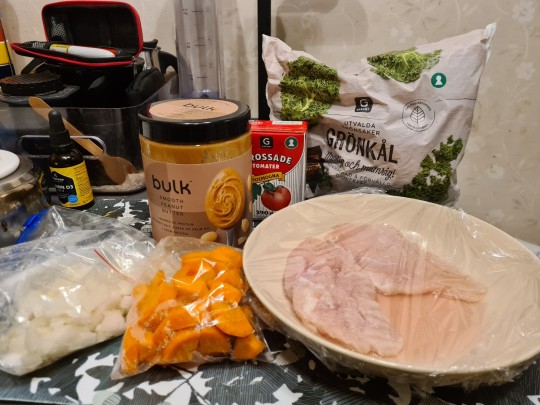
I'm pretty low on spoons today after the monthly Medical Hell Day yesterday, but I really wanted some halfway decent food now that I'm in better shape to eat it again. Haven't been eating very well or enough for the past week or so again.
So, plan getting underway to turn out my own makeshift version of a vaguely West African-influenced peanut chicken stew to go with some rice. Haven't made any for years, and it seemed like a decent use for some ingredients we had on hand. Including some of the good chunk left in that kg jar of 100% peanut butter. (I also really need to do some baking with it before it starts going rancid.)
Tonight that is evidently going to include some thawed out frozen chicken breast (not my favorite but okay), frozen kale, and a really big carrot. Which I did have the sense to cut up in advance last night along with the onion, while I had more energy and was thinking about it.
Another of those things that's more of a method than a set recipe. It should be fine. ¯\_(ツ)_/¯
A couple of takes on similar:
10 notes
·
View notes
Text
IT'S STEW SEASON YAY ❤️
#i almost forgot#pfffff#what are your favourites?#i love potato lentil carrot stews & pretty much anything containing beans#stews#food
3 notes
·
View notes
Text
Winter Comforting Stews
And on cold days when you fancy something warming and hearty, these Winter Comforting Stews are just what you are looking for. Slowly simmered meat or fish, in a broth or thick sauce, but always fragrant and tasty! These few recipes, from all over the world, make one relish a a numbing chill!
Poulet D.G. (Chicken E. O.)
Stoofvlees (Dutch Beef and Beer Stew)
Spinach, Sweet Potato and Lentil Dahl (Vegan)
Potée Auvergnate (Ham Hock, Sausage and Vegetable Stew)
Bourguignon Stew with Cheese Dumplings
Poulet Basquaise (Basque Chicken)
Prawn and Trout Bouillabaisse
Sea Bass with Potatoes and Carrots in Saffron Cream
Burns Night Scotch Broth
Petit Salé aux Lentilles (Ham Hock and Lentil Stew)
Lamb Tagine
Sweet Potato Chicken Curry
Hearty Chicken and Dumplings
Chicken Mafé
Beef Stew with Fluffy Dumplings
#Recipe#Recipes#Recipe List#Winter Comforting Stews#Stew#Stews#Stew recipe#Beef Stew recipe#Lamb Stew recipe#Pork Stew recipe#Fish Stew recipe#Chicken Stew recipe#Vegetarian Stew#Vegan Stew#French Cuisine#British and Irish Pub#Belgian and Dutch Kueken#West African and Cameroonian Kitchen#Indian Rasoi#Recipe Box#Winter#Winter recipe#Winter recipes#Winter Warmers
18 notes
·
View notes
Text

Credit: gayest.detective
#soup#memes#meme#dank#dank memes#ifunny#humor#lol#lmfao#witchcraft#joke#scenes#funny moments#laugh#lmao#share#reshare#reblog#soup is life#stews#gas prices
7 notes
·
View notes
Text

Yabeh - West African Cassava Stew (Vegan)
#vegan#lunch#dinner#west african cuisine#stews#cassava#sweet potatoes#onion#ginger#tomato sauce#peanut butter#cayenne#spinach#olive oil#sea salt
30 notes
·
View notes
Text

Lily Maymac 🌸💋🍒🌸 Cold weather food 😋
#lilymaymac#beautiful#sexy#babes#models#instagram models#food porn#selfie#april 2023#america#colorado#aspen#monday 10#aurum#food n wine#delicious#food cravings#soup#stews#sexy smile#ash blonde#8am
3 notes
·
View notes
Text

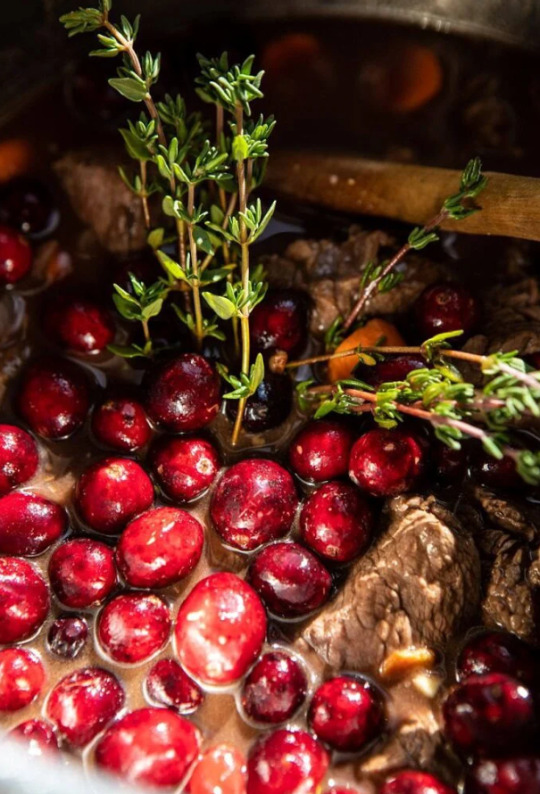
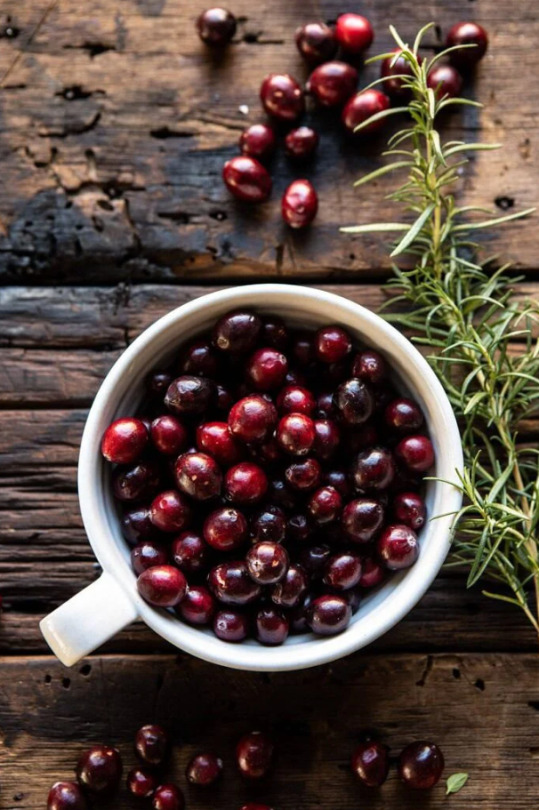
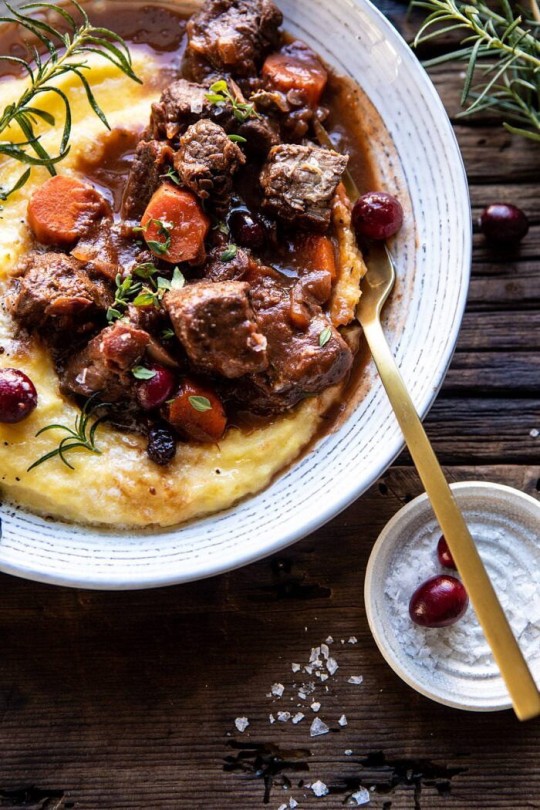
Cranberry Cider Braised Beef Stew with Rosemary Polenta
129 notes
·
View notes
Text
Created soup commuinity
Soup Lovers
https://www.tumblr.com/join/m9katmRl
4 notes
·
View notes
